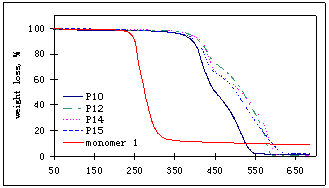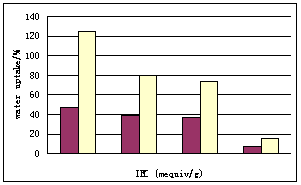Perfluorinated ionomers containing the bis(perfluoroalkyl)phosphonic acid
Darryl D. DesMarteau, Li-Mei Jin and Stephen Creager
Department of Chemistry, Clemson University,ARML, 91 Technology Drive, Anderson, SC 29625
Introduction
Bis(perfluoroalkyl)phosphonic acids are known to be very strong protic acids. Incorporation of this acid function into a perfluorinated ionomer might have potential for use in PEM fuel cells. Previous research on related perfluorinated ionomers containing the monoalkylphosphonic acid function had shown some promise for fuel cell applications but the investigations were limited.1,2 We have developed methods for the synthesis of novel bis(perfluoroalkyl)phosphonic acid vinyl ether monomers and have prepared copolymers with tetrafluoroethylene. Some preliminary evaluation of these polymers will be presented.
.
Experimental
Typical procedure for the polymer synthesis
The copolymerization of the monomer with TFE was initiated by K2S2O8 with Na2HPO4/NaH2PO4 as pH buffer. 3 A 450 ml autoclave was precleaned with nitric acid, rinsed, and thoroughly dried. Approximately 800 ml of distilled water was degassed overnight using nitrogen before use. A sample of monomer RFP(O)(ONa)C4F9, 1 or RFP(O)(ONa)CF3, 2 (RF: CF2=CFOCF2CF(CF3)OCF2CF2), Na2HPO4, and NaH2PO4 were dissolved into 210 ml of degassed distilled water and bubbled with N2 gas overnight. Similarly, the solution of K2S2O8 (30ml) was also bubbled with N2 gas overnight. Then the two solutions were mixed and pulled into the fully evacuated autoclave, and followed by washing with 20 ml of degassed distilled water. The mixture was heated to 65oC, after desired amount of TFE was consumed as determined based on pressure drops which calculated using van der Waals equation, the TFE was vented and then the mixture was acidified with 36% HCl solution (10ml) and a gel-like solid formed. After the polymer was washed with dilute HCl solution, H2O and Et2O subsequently, then dried at 120oC under full vacuum for 24h, a white powder polymer was obtained.
Formation of membrane
Membranes were cast on aluminum foil (8×8cm). The polymer (1g) was heated in EtOH(70ml)/DMAc(70ml) at 70oC for 24h and then blended for 2min. After filtered with a nylon cloth, the solution was put onto alumina foil and vacuumed at 100oC for 4h, then heated at 250oC for 2h and a light brown film formed. The film was washed with HCl (36%), refluxed in 70% HNO3 and then boiled in repetitive deionized water to give a colorless, tough and flexible film.
Characterization Methods. Thermogravimetric Analysis were obtained with a Perkin-Elmer TGA7 thermogravimetric analyzer under N2 at a heating rate of 20oC/min from 50 to 700oC and Differential Scanning Calorimetry were recorded on a DSC7 at a heating and cooling rate of 10oC/min from 50 to 370oC. Impedance measurements were made using Solartron 1255B gain phase analyzer and Solartron SI 1287 potentionstat. The instrument was used in galvanostatic mode with voltage amplitude of 50mV with over a frequency range from 10 to 20000Hz.
Results and Discussion
Figure 1 shows a thermograph of the bulk copolymer material (from monomer 1) at different equivalent weight under N2 atmosphere.

Figure 1. TGA of copolymer P10, P12, P14, P15 and its monomer 1.
The first step in the weight (%) loss corresponds to the loss of the perfluoroalkylphosphonic acid function, compared to the decomposition temperature of the monomer (245oC), the typical onset for thermal decomposition of these polymers is around 400oC. The second decomposition temperature (around 500oC) is because of weight loss of the PTFE back-bone. By comparing the second onset temperatures of the polymers, the approximate content of TFE could be estimated. For example, compared to higher onset of P12 (EW:1250 g/mol), P14 (EW: 1000 g/mol), and P15 (EW: 900 g/mol), the lower onset of the P10 (EW:750) was observed, which means P10 has lower TFE content. This is consistent with the results from the titration. The DSC curves of the copolymers with various EW also gave similar results. Undoubtedly, the endotherm peak at 320-350oC is due to the melting (Tm) of the PTFE crystalline region in the copolymer. From the DSC measurement, the endotherm (324oC) and exotherm (310oC) peaks were observed for P12 while no such peaks were observed for P10, which indicated the extent of crystallinity increased for P12 due to more TFE in the polymer. The typical onset for thermal decomposition of the membranes is similar to the bulk polymers.
The water uptake of membranes was measured by soaking the membranes in water at room temperature or 100oC for 24h. The results are summarized in Figure 2.

Figure 2. Water uptake at room temperature (left column) and 100oC (right column) vs IEC (copolymers from copolymerization of RFP(O)(ONa)C4F9 with TFE).
The water uptake of membranes, treated with refluxing water, with IEC values of 1.33, 1.1, 1, 0.8 mequiv/g was 124, 80, 74 and 16%, respectively. As expected, P10-mem (membrane from polymer P10) showed the highest water uptake among these membranes, corresponding to absorption of 33 water molecules per phosphonic acid. On the other hand, the P12-mem (membrane from polymer P12) membrane, with the lowest IEC value, showed the lowest water uptake value, corresponding to 6.6 water molecules per phosphonic acid. The room temperature water uptake of these membranes increased with increasing IEC as well. While increasing temperature, the water uptake value increased. For example, P10-mem showed water uptake of 124% at 100oC while 47% at room temperature. It is worthy to mention that the membranes do not show obvious swelling in cool and hot water. Their strength was still retained in a wet state.
Proton conductivity
Proton conductivity data were acquired for samples P10-mem (IEC = 1.33 mequiv/g), P12-mem (IEC = 0.8 mequiv/g), P14-mem (IEC = 1 mequiv/g) and P18-mem of the ionomer at 100% RH at three temperatures between ambient, 80oC and 120oC. The membranes were hydrated by soaking in hot deionized water for 24h prior to study. Representative results are given in Table 1.
Table 1. EW, and conductivity of ionomer membranesa
membrane | EW g/mol | Conductivity 25oC | Conductivity 80oC | Conductivity 120oC |
P10-mem | 750 | 0.026 | 0.025 | 0.046 |
P12-mem | 1250 | 0.006 | 0.018 | 0.013 |
P14-mem | 1000 | 0.014 | 0.021 | 0.035 |
P18-mem | 1100 | 0.044 | 0.122 | 0.124 |
a. The monomer for P10-mem, P12-mem, and P14-mem is RfP(O)(ONa)C4F9; while the while the monomer for P18-mem is RfP(O)(ONa)CF3.
The ionomer P10-mem and P12-mem showed the proton conductivities 0.025 and 0.019 S/cm at 80oC respectively. Their conductivities increased with increasing IEC. Interestingly, increasing the temperature from 80oC to 120oC, the conductivities of P10-mem increased nearly double times, from 0.025 to 0.046 S/cm. The good water holding capability above 100oC might be responsible for high proton conductivity of P10-mem membrane. Although the conductivity decreased a little bit (from 0.019 to 0.014 S/cm) for the P12-mem (IEC = 0.83), the mechanical strength was unchanged. Interestingly, after adjusting the ionomer structure, to replace the perfluorobutyl group with a trifluoromethyl group, the resulting membrane (P18-mem) gave much better conductivity. It showed the conductivity of 0.044 S/cm at room temperature. Importantly, the conductivity of P18-mem was 0.122 and 0.124 S/cm at 80oC and 120oC respectively, which is similar to that of the Nafion112.
In conclusion, a series of new bis(perfluoroalkyl)phosphonic acid-based copolymers with TFE were prepared using aqueous emulsion polymerization method. Tough flexible membranes were formed readily by solution casting. The ionomers are stable up to 350oC by TGA (N2). The ionomer membrane P10-mem (from monomer RFP(O)(ONa)C4F9, IEC = 1.33 mequiv/g) showed conductivity (100% RH) at 120oC (0.042 S/cm) while the membrane P18-mem (from monomer RFP(O)(ONa)CF3 , IEC = 0.9 mequiv/g) gave rather good conductivity at 120oC (0.124 S/cm).
Acknowledgment
This work was supported by U.S. Department of Energy.
References
1. Kotov, S. V.; Pedersen, S. D.; Qiu, W.; Qiu, Z.; Burton, D. J. J. Fluorine Chem. 1997, 82, 13-19. 2. Yamabe, M.; Akiyama, K.; Akatsuka, Y.; Kato, M. European Polymer Journal 2000, 36, 1035-1041.
3. Thomas, B. H.; Shafer, G.; Ma, J. J.; Tu, M.; DesMarteau, D. D. J. Fluorine Chem. 2004, 125, 1231-1240.

